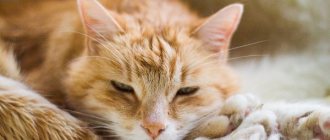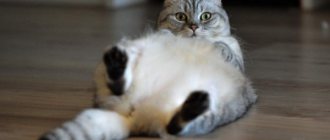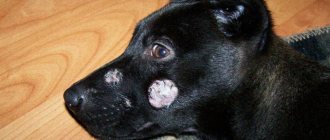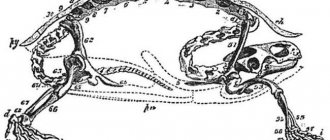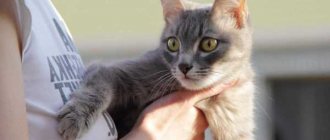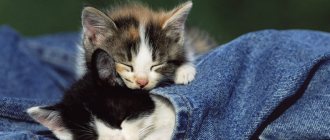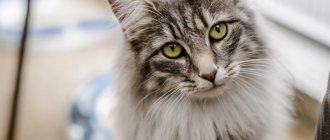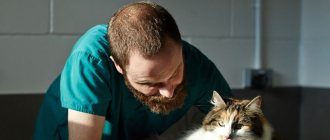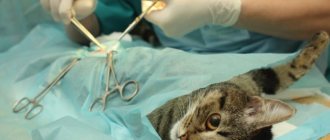- Sterilization of a cat. Methods and risks
- How to trim a cat's claws correctly?
- How to retrain an aggressive cat
- Cats versus sofas: how to stop a cat from scratching furniture
- Such amazing and mysterious cats
Does the cat arch its back? Does she suddenly start running like crazy, as fast as she can, circling the room, jumping over couches or up and down the stairs, with her fur standing on end? It's very funny and interesting to watch, and at the same time scary, because she might bump into something and hurt herself. But she seems to be having a great time. Is it harmless fun or a cause for concern?
Most cats exhibit this behavior. Cat adventures, also known as periods of frantic random activity, are a normal and fun activity for them, although it can drive you crazy if they happen at 2 am.
When does this happen?
It comes out of nowhere. Sometimes the cat seems to “see” something invisible and starts running, or it may be in a playful mood, which may be aggravated by play. Cats also practice their stalking, hunting, and chasing behaviors, and this can cause them to arch their backs. There can be many reasons for this. After all, running is fun!
Kittens and young cats are more likely to fall into this state as they are full of energy and this can be a way of burning off excess energy. But sometimes even older cats can arch their back. Cats sleep most of the day when their owners are at work, so when they return home, the animals are awake and full of pent-up energy.
Playing
Cats may also arch their back when playing. . You can tell this more playful cat from an aggressor by the fact that she won't growl, hiss, spit or show her teeth. Instead, he will likely engage in a variety of jumping and running activities, which may be directed at another cat, a toy, or a person with whom the cat is friendly and comfortable.
Should I worry?
Your cat may need more exercise. Set aside time every day to play with her and provide her with toys and puzzles filled with food. Change her toys to new ones periodically so that she doesn't get bored with them.
There are medical reasons why a cat may begin to exhibit this behavior. If an older or lazy cat suddenly becomes abnormally active and restless or behaves strangely, your veterinarian may want to check for any health problems such as feline hyperthyroidism (an overactive thyroid gland).
Older cats suffering from cognitive dysfunction syndrome or dementia may also begin to run around uncharacteristically. Cats that are experiencing physical changes, such as vision or hearing loss, may also begin to arch their back, and if this is a strange behavior for your pet, a visit to the vet is recommended.
Behavioral problems may be related to anxiety or stress, where the cat may become hypersensitive to stimuli in its environment and react by running uncharacteristically. Even flea or insect bites can cause her to arch her back to relieve irritation or severe itching, so check her coat for parasites.
If your cat shows any sudden changes in behavior, it is recommended that you take him to the vet to rule out any medical problems. If her behavior seems unpleasant and there is no medical explanation, seek help from a qualified cat behaviorist.
Causes
Cats find themselves in a variety of situations throughout the day. They might run into a rival kitty on the block or get a pet from their loved one. All of these interactions require different responses. So let's dive into why cats may arch their backs and what it means.
© shutterstock
- After a good night's sleep, the cat arches its back to stretch its muscles . It activates all the muscles that were inactive due to sleep. Cats are much more flexible than people.
- When a cat feels threatened by anything , any person or any other animal, they will begin to arch their back to show that they are in attack mode. When a cat feels threatened, its fur begins to stand out specifically on its tail. Cats do this because it makes them look larger and more aggressive. She may even begin to show her side profile, displaying more aggressive body language to ward off a threat, be it a thing, person, or animal. When your cat arches his back, raising his fur, and begins to grind his teeth, hissing at something or someone, he is afraid of that object or person and wants it to go away.
- But cats also arch their backs when they are playing or having fun . But this time they won't growl or hiss. Instead, they will start jumping and lashing out at someone they are comfortable with or feel safe with.
- Cats are very sensitive creatures, so tail lifting and arching can be caused by hormones , muscle strain, or misfortune. Sometimes they get angry when someone invades their territory. Pain is another real factor that causes cats to arch their backs.
- But when a cat feels happy and content, she begins to arch her back . When you pet a cat and it feels good, it will begin to arch its back and sometimes come closer to you, purring. This is their body language to let you know that they are happy and content with your company.
- When you pet your cat, she may think it's time to eat . Some young cats believe that petting is a sign that their owner is about to feed them. Some cats love to eat after being petted. For the same reason, they begin to arch their back.
- When a cat is in pain, it will often begin to arch its back . If your cat arches her back for reasons related to pain, she will do this constantly. Whenever she feels pain, she reflexively begins to arch her back. Other causes of back arching are not permanent, but pain-related causes are permanent.
What to do?
Have fun watching your cat release pent-up energy! If this happens at night and disrupts your sleep, play with her regularly during the day and early evening and feed her before bed.
Cats are crepuscular animals, which means they are most active at dusk and dawn.
The nervous system is one of the most important in the body of every living creature. Any deviation from the norm affects general well-being and behavior. Some cat owners notice their cat walking sideways. This is strange behavior and may indicate a number of abnormalities. To restore the pet to its normal state, the animal should be examined and the cause of the disease should be identified.
Stretched or stretched
Finally, cats sometimes arch their backs when stretching, just like humans, except they are much more flexible than us . Very common postures in cats include stretching the head and chest down and the tail up, with the hind legs extended back while the weight is primarily supported by the extension of the front legs and the extension of the back.
So your cat's arched back could mean "Stay away!" “Come and play with me?” or “Wow, I feel so good!”
Now you know why your cat may be walking sideways... It could be nothing or a reason to see a veterinarian as soon as possible.
The main reason why cats walk sideways is ataxia.
If the nervous system is damaged, cats may have ataxia. This disease occurs quite often. Ataxia is a pathology that describes a range of symptoms that generally manifest themselves as a lack of coordination. There is a disruption in the position of the body in space, and the cat often jumps sideways, simply walks with a twisted body, or even jumps. There are three types of ataxia:
- Cerebellar. The name comes from the location of the organ dysfunction, that is, the cerebellum, which is located in the brain. When this section is damaged, the animal begins to behave strangely, walk sideways, hit walls, fall, stagger while moving;
- Vestibular. This type of ataxia is manifested by a violation of the vestibular apparatus, which is located in the middle part of the ear. This phenomenon may occur against the background of another disease, for example, an inflammatory process - otitis media, organ damage after a blow, a fall or a fight with relatives, as well as a congenital disease and development of the pet’s ears;
- Sensitive. In terms of symptoms and manifestations, it is very similar to the cerebellar one. The only difference is the location of the lesion. In the case of sensitive, this is a disease or improper functioning of nerve cords in the brain.
If a cat begins to walk or run sideways, you should pay attention to the general condition of the animal and take it to a veterinary clinic. After undergoing tests and hardware diagnostics, the doctor can make the correct diagnosis and prescribe adequate treatment.
Causes of ataxia
Ataxia can be not only a congenital defect, but also a consequence of a number of other pathologies. Among the most common negative factors are the following aspects:
- poisoning. Various chemicals used in domestic conditions or substances used to poison rats and mice can cause poisoning in a pet's body. Cats are very sensitive to odors, so the cause may be not only eating the composition, but also steam fumes that enter the respiratory tract, and then into the blood through the nasal passages. Poisoning is always accompanied by a number of negative and severe symptoms for cats. Such signs include severe vomiting, loose stools, foaming at the mouth, bleeding from the nose or mouth, loss of consciousness, and poor appetite. In this case, urgent help is required. First of all, gastric lavage is performed (if the cat has eaten toxic substances), then sedatives and adsorbent medications are administered, which will help remove toxins from the pet’s body. Sedatives are also necessary in order to calm the furry one and avoid psychological trauma. Treatment is carried out for several days, then rest and proper nutrition are recommended;
- head injuries. It is very often observed during spring days, when mating time begins for cats. These days, animals behave especially actively and are often injured in fights with relatives. Skull injuries can be caused by a fall, for example from a balcony. As a result, coordination is impaired. The cerebellar area, nerve pathways or vestibular apparatus begins to dysfunction. As a result, the cat runs sideways. Treatment is prescribed only by a veterinarian after he has taken an X-ray or MRI of the pet’s head;
- violation of metabolic processes. Very often occurs as a result of hormonal imbalance or poor nutrition. Some owners like to pamper their pets with fresh river fish. Such a diet causes a lack of vitamin B1, since the thiaminase enzyme contained in fish destroys thiamine (or B1). As a result, ataxia develops. Metabolic processes are often disrupted when an animal is sterilized, so owners note that the cat walks sideways after sterilization. Treatment can only be prescribed by a doctor;
- a brain tumor. Oncological diseases and growing tumors in the animal’s head compress the nerve pathways and lead to a malfunction in the central nervous system. In this case, systematic treatment and constant monitoring by doctors are required. In some situations, only surgery can save a cat;
- infectious disease - panleukopenia. A severe infection affecting the nervous system in the body;
- harmful plants. Often found in free-ranging cats. Animals love to eat various herbs on the site. If your pet is addicted to mint, he may develop ataxia. As a result, the cat will begin to walk sideways. To eliminate the symptom, you need to monitor what the animal eats and eliminate it from the diet.
Proper nutrition and regular examinations by veterinarians will allow your cat to remain healthy and cheerful. An active pet is the joy of the owner.
Loss of motor coordination in cats is the main symptom of ataxia. The pathology causes great discomfort to the animal, as it is expressed in a disorder of motor function due to damage to the central nervous system. Only a veterinarian can give recommendations on what to do if a cat has poor coordination of movement. If pet owners are faced with such a problem, they should immediately seek help.
Other diseases Unnatural behavior or posture in a vetna cat
Sometimes, for no apparent reason, your pet suddenly changes its daily behavior. The owner should be wary - this may be a sign of a disease that can only be diagnosed by a veterinarian. Before going to the clinic, you should take a closer look at the cat. Immediately go to the doctor if she refuses food and drink, reacts painfully to being touched or picked up, her breathing rhythm changes, her fur is tousled, does not fit correctly to her body, the cat takes unnatural positions when walking, sitting or lying down. All this is a sign of several diseases, including inflammatory processes of internal organs, poisoning, serious injuries (falling from a height, beating, etc.). Unnatural behavior and posture may not be associated with any disease. The fact is that the behavior of an animal is changeable, due to age, biological characteristics (readiness for fertilization, childbirth, etc.), ethology (the natural disposition and habits of the animal are determined), and the lifestyle of the owners themselves. Pets adapt to certain living conditions based on personal experience. Also, it has been scientifically proven that animals are susceptible to changes in the electromagnetic field of the Earth, therefore the behavior in which it rushes around the territory (house, yard, etc.), and then suddenly calms down, huddled somewhere (lasts about 24-48 hours) - indicates the likelihood of a natural disaster or earthquake within a radius of 100-150 km from the epicenter. The owner should be alarmed by the appearance of the symptoms listed at the beginning of the article. If a cat behaves unnaturally, takes positions that are unusual for it, first of all, this is a sign of illness or injury. Any slightest change in the behavior of a pet that is not inherent in its lifestyle in a healthy state is already a signal for immediate observation, a step towards qualified consultation.
Possible reasons for behavioral changes
The owner notices the fall (beating) of the animal as soon as possible. Symptoms: stops actively moving (even to the point of lying in one position for a long time), unable to approach food, water (or cannot take the correct position for eating); meows pitifully (especially if touched or lifted), lethargic, breathes heavily; signs of mechanical damage are visible on the body (blood, bumps, dislocations, limping, etc.). To avoid consequences from bruises and fractures, you should immediately show your cat to a veterinarian. Symptoms of tetanus: sudden short-lived (clonic) convulsions, when after each muscle contraction there is a relaxation; Coordination is impaired, it is difficult to open the jaw, etc. There may be tonic spasms: the muscles are in a state of contraction-relaxation for a long time, and the animal’s body seems to become stiff. Similar abnormal behavior also occurs with other infectious, viral, bacterial diseases (including toxicosis from the presence of helminths), or with pathology of systems in the cat’s body. Symptoms that occur with rabies: excessive affection of the pet is sharply replaced by aggression; can throw itself at inanimate objects (things, trees, fences); swallows inedible objects; aggressiveness towards other living beings (people, animals), increased salivation. The second stage of rabies is characterized by photophobia and hydrophobia (hides into darker places, is afraid to drink), excessive timidity, convulsive movements are observed (as if catching flies with its teeth), prolonged meowing (similar to howling or other sounds that are not characteristic of a cat). Inflammatory processes in the animal’s body and poisoning are the most difficult to diagnose for the owner. An exacerbation of the disease is easier to notice, since the pet’s behavior suddenly takes on an unnatural form: changes in temperature, attacks of pain are accompanied by an angry hissing (even growling), loud meowing, the cat takes unnatural positions in order to lie down and ease the pain in a certain area; Neuralgic attacks occur (convulsions, throwing the head back, etc.); nervousness (throwing around, frequent licking), the gaze becomes glassy, as if going nowhere. In the chronic course of the disease, the animal becomes apathetic, refuses to eat, stops caring for itself, refuses to go for walks, etc. Other reasons for unnatural behavior: changes in gait, reluctance to move, may indicate an accidental injury while walking. If a cat is constantly on its feet, refuses to lie down or sit down, it may have chest and stomach pain. There are a lot of reasons, ranging from bruises to intestinal obstruction. In any case, even if you know the reason for unnatural behavior or posture, consult a specialist. Your pet will be grateful for the speed of assistance provided for a quick recovery. Dear readers, this article is not a tutorial or instructions for self-treatment of cats. The animal needs the help of a specialist, because only in a clinical setting, based on research, using appropriate equipment, will the diagnosis be correctly established. Any delay or unqualified treatment can cost your pet’s life. Take care of your pet's health.
Causes of cerebellar ataxia
The main cause of impaired motor coordination in cats is infections that affect the central nervous system and brain. Most often, ataxia develops against the background of panleukopenia.
Loss of coordination is the main sign of pathology
Cerebellar ataxia in cats is a hereditary disease with a genetic predisposition or develops as a congenital form. It can appear as a result of an intrauterine developmental disorder in kittens.
Also reasons may be:
- traumatic brain injuries;
- cerebral edema;
- inflammatory processes;
- damage to the inner ear due to otitis media;
- neuritis of the craniofacial nerve;
- tumors.
Veterinarians include hernias between the vertebrae and spinal cord injuries as possible causes of incoordination in cats.
General group of symptoms for all types
The disease has species-typical and generally similar symptoms. The different symptoms depend on the causes. All types of pathology are characterized by:
- the cat holds its head atypically, it can tilt it to the side or lower it down;
- a staggering gait is observed, the animal loses coordination, the cat can walk, raising its hind legs high.
If the animal's spinal cord is damaged, it will experience pain when walking. Such cats try to hide in a quiet place and move less.
Attention! In severe forms, paralysis of the hind limbs can develop in cats.
With cerebellar ataxia, tremor occurs when running or walking. The kitten will often tremble, and most often the trembling is noticeable only in the back of the body. The cat also has dilated pupils and poor coordination.
If the vestibular apparatus is affected, the cat will suffer from severe headaches. Such animals constantly meow, hide in the corner, pressing their foreheads against the wall.
Hind limb paralysis
Localization of damage in ataxia
Depending on the location of the source of inflammation, the pathology is divided into the following groups:
- Cerebellar - appears with inflammation of the medulla oblongata and cerebellum. The disease can be either congenital or acquired.
- Vestibular - with inflammation of the inner ear system.
- Proprioretic - a form caused by damage to peripheral nerves.
- Spinal cord develops against the background of damage to the spinal cord.
In veterinary medicine, there are two forms of ataxia:
- static;
- dynamic.
In the first case, the kitten will not even be able to stand straight; in the second, on the contrary, coordination is impaired only during movement.
Pathology in kittens from birth
Types of ataxia
Depending on the area of damage, there are two main types of pathology.
Sensitive ataxia (proprioceptive)
This form of the disease occurs due to damage to the spinal cord or peripheral nerves. The occurrence of the disorder may be influenced by the presence of a tumor in the intervertebral discs in the cat.
The animal loses the ability to flex and extend its paws at the joints. It cannot consciously choose the direction of its movement. The cat is experiencing severe pain in the back and neck. In severe forms of the pathology, the cat cannot move completely.
Attention! If the brain is only partially damaged and treatment is given early, your pet has a chance of a full recovery.
Vestibular ataxia
The diagnosis of vestibular ataxia is made if the inner ear system is affected and there is also a tumor of the brain stem. Pets over ten years of age most often get sick. The cat cannot stand, it falls on its side. The head tilts towards the affected side. The animal moves very slowly and carefully. Vomiting is sometimes observed.
Vestibular ataxia can occur due to:
- development of a brain tumor;
- otitis media;
- infections;
- injuries when cleaning ears;
- drug overdose.
Important! The first sign of pathology is that the cat is sitting in the corner, leaning its forehead against the wall.
Signs of vestibular ataxia
How to react to a cat's arched back?
If you ever find yourself in a situation where your cat arches her back aggressively, you'll want to slowly back away from her. Typically, a cat will arch its back angrily because it wants the threat to go away. If you try to approach her, she may attack you.
But when you see your cat coming up to you or sitting on your lap and arching his back, it means he is happy and comfortable around you and wants you to pet him. In my personal experience, don't try to force anything. Let your cat come to you and then pet her slowly and gently. Cats don't take well to being forced.
Now, if you notice that they are coming towards you while jumping up and down, it means that they are in a playful mood and want you to play with them. This can strengthen the bond between owner and pet. In this situation, play with it a little. This will make him more affectionate towards you. Then he will trust you more and may obey you.
© shutterstock
Well, if you want to get out of a situation where your cat is arching its back and you feel threatened by it, just slowly move away from the cat. Because he shows that he doesn't want to be in that situation. They don't want you around them at the moment, so just leave him alone. This is the wisest thing you can do at this moment.
Well, there is another case where a cat shows its side profile by arching its back. This is called a side jump. This usually starts with the cat standing on all fours outstretched, showing his side to you, and then starts jumping up towards you. Always know that lateral jumping is not an aggressive expression of the cat. He just wants to play. If you also want to play with him, you can copy his moves in a non-violent way.
Diagnosis of ataxia in a cat
The main stage in diagnosing pathology is a complete history taking. The veterinarian must determine whether the animal had injuries or whether it suffered from infectious diseases. If possible, find out information about heredity and the course of pregnancy if we are talking about pathology in a kitten.
The animal's nervous system is assessed and tests are taken to identify viral pathogens. It is recommended to do an MRI of the brain to see tumors or areas of bruising. It is necessary to examine the ears using an otoscope.
As soon as there is a suspicion that infection is occurring in the area of the brain or spinal cord, a test for leukocytes in the cerebrospinal fluid is required.
Diagnosing disease in pets
Diagnostics
Diagnosis of vestibular diseases requires a thorough history and careful examination. To choose the direction of diagnosis, it is important to first determine whether it is a central or peripheral disorder. It is necessary to check both auditory tracts and eardrums along with an assessment of the neurological condition of the animal.
Basic laboratory tests include a complete blood count, blood chemistry panel, and urinalysis. Basic testing will also include tests for feline leukemia virus, feline immunodeficiency virus, and titers for feline coronavirus, toxoplasmosis, and cryptococcus. Evaluation of elevated immunoglobulin G titers and the presence of immunoglobulin M titers may be a sign of active toxoplasmosis infection.
X-rays of the head can help detect ear diseases by identifying changes in the tympanic bulla. However, x-ray is not a specific diagnostic method and does not show the soft tissues involved in the pathological process. New imaging techniques such as computed tomography (CT) or magnetic resonance imaging (MRI) are much better at localizing lesions in the ear or brain. MRI is particularly useful in detecting soft tissue lesions.
Because MRI is expensive, it is more often used to distinguish between central (brain) and peripheral (ear) disease after basic preliminary tests have been performed.
If encephalitis is suspected, cerebrospinal fluid (CSF) is taken for analysis. One of the most common causes of encephalitis is feline infectious peritonitis (FIP). FIP occurs primarily in cats under two years of age and is a progressive disease. The brain stem and spinal cord are the first to be affected. CSF analysis will demonstrate elevated levels of protein, predominantly globulins, and a moderate number of white blood cells, predominantly neutrophils or lymphocytes. Antibody titers or PCR virus presence may be inconclusive.
Treatment of cerebellar ataxia in cats
The chances of recovery and treatment methods for feline ataxia depend on the general condition of the animal and the reasons that caused the development of the pathology. The cat has the opportunity to fully recover and return to a healthy lifestyle if the owner consults a veterinarian in a timely manner.
The measures taken by veterinarians when diagnosing ataxia may be as follows:
- If the pathology is caused by a tumor, surgery is used. After its removal, the symptoms disappear.
- In case of poisoning, measures are taken to relieve intoxication. The animal is prescribed IVs, injections of vitamin B1, and diet.
If the pathology occurs against the background of brain defects, it can occur in mild, moderate and severe forms. The disease cannot be cured, but in mild cases it is possible to save the kitten. This will require full-time care.
Kittens are prescribed the drug "Gamavit" to strengthen the immune system. To improve the functioning of brain tissue, Glycine is recommended at a dosage of 250 mg, 1 tablet per day. The course of admission is 14 days.
Most often, the condition stabilizes after the kitten turns one year old.
Treating a pet for poisoning
Treatment on an outpatient basis and at home
It is important that therapy is carried out comprehensively. The treatment regimen is developed depending on the cause that caused the development of the disease. In this regard, the dosage of drugs may differ even if we are talking about the same form of pathology.
The following medications are most often prescribed:
- vitamin complexes, B vitamins;
- to eliminate infections - antibiotics;
- for swelling of the brain - diuretics;
- Hepatoject for liver dysfunction;
- to improve blood circulation in the brain - Cerebrolysate;
- saline solutions in droppers to relieve intoxication.
Physiotherapy and massage are recommended for the animal. If the spinal cord is affected, surgery is required.
Important! You should not try to treat yourself. A sick animal requires professional advice from a veterinarian. The severe form cannot be eliminated using folk methods alone without an integrated approach.
Vitamins for full recovery
Prevention of ataxia
Despite the complexity and severity of the pathology, pet owners can create the necessary conditions to avoid its development. First of all, it is necessary to avoid any factors that could lead to injury. It is not recommended to let your animal go outside unattended.
The following should be used as preventive measures for the development of ataxia:
- Timely contact a veterinarian if there is a suspicion that the animal has a traumatic brain injury.
- Vaccinations in accordance with the schedule against leukemia, panleukopenia.
- Treatment of inflammation in the ear canals is mandatory.
- Examine the cat for panleukopenia before mating is planned.
- During pregnancy, protect the cat from contact with other animals.
Important! Loss of coordination can be effectively treated through physical therapy. Veterinarians recommend working with your pet and provoking it to play. Activity is very necessary for a kitten with ataxia.
Ataxia in cats is a complex disease, but with a competent and timely approach, the pet owner can return it to normal life. Caring and adherence to preventive measures effectively influence the healing process.
Sometimes veterinarians hear complaints that “the cat has a hunched back,” “the cat is hunched over,” or that the cat has a curvature of the spine. Most often this indicates kyphosis. Kyphosis (ancient Greek κύφος - bent, humpbacked) is a curvature of the upper spine with a clear bending back. This problem can occur in cats of any breed. However, the question more often asked is why exactly does a fold-eared cat hump? This is due to the fact that the Scottish cat breed is more susceptible to problems with the musculoskeletal system.
The diagnosis of “kyphosis” is made by a veterinarian, and ordinary people unknowingly call this pathology a hump. From now on we will use the word “kyphosis”. So, why does a Scottish Fold or Straight-eared cat hunch and why does a Scottish Fold hunch when walking?
How to get a cat to stop this behavior?
Now, listen carefully, we eat, sleep and do what comes naturally to us. Arching the back is natural for cats. This is their way of protecting themselves as well as being playful. Under no circumstances should you suppress natural urges. It's not good for them. If you love your cat, just let her behave naturally. If you try to get her to stop arching back, she may become aggressive towards you. She may attack you.
When a cat is scared, it will naturally arch its back, showing its aggressive side, because it makes it look a little bigger, fiercer, and meaner. This often scares away their potential enemy. So this behavior is a lifesaver for them.
And when they play with you, they arch their back to show that they want to be with you, isn't it such a nice feeling when your pet loves you back? He will start pouncing and jumping on you and this will make you more joyful when you see your cat being playful and happy. She will listen to you in this mood because she is saying that she loves your company.
In my personal experience, try to keep your surroundings as calm and pleasant as possible. As a result, he will not become aggressive and, as a natural result, he will not arch his back while being completely protected.
Why do Scottish Fold and other cats hump? Is this kyphosis?
It is necessary to distinguish pathology from the norm. The first variant of the norm is when a cat arches its back due to fear. All cats have this property: they try to appear bigger and scarier when they encounter danger. This is also called “standing on end.”
The second variant of the norm is that the cat has a slightly rounded back. This is typical for some breeds, for example Scottish cats. But in this case there are no outgrowths on the back: it is only slightly rounder than that of other cats. It looks like this.
If the back is normal, the cat shows no signs of pain when touched, jumps and runs, and leads a normal life. When do we talk about pathology? When there is pain, when the hump increases in size, when the back no longer looks natural. This is what a cat with a “growth” on its back looks like. Here is an x-ray.
However, you cannot make a diagnosis yourself, because without having the necessary knowledge, it is easy to make a mistake. For example, curvature of the spine in cats is confused with sarcoma. This is a tumor that needs to be removed.
Going to defend himself
First, and widely seen in many popular fall images, is the image of the aggressor of fear. . In this classic Halloween pose, the cat arches its back and exhibits piloerection (meaning its hair stands on end) to appear larger when facing danger. When a cat acts this way, it's basically saying, "I'm afraid of you, but I'm ready to defend myself if you approach." A cat may also indicate that it is ready to defend itself by doing things such as growling, hissing, spitting, and showing its teeth. If you encounter a cat exhibiting this physical condition, the best response is to slowly back away and give the cat its space.
Article topic:
How to Interpret Cats Body Language
Humpback and kyphosis: causes
In the case of a pathology called kyphosis, acquired and hereditary varieties are distinguished.
Congenital kyphosis occurs as a result of abnormal development of the anterior part of the vertebrae. In particular, congenital kyphosis can occur due to improper selection of a pair of parents. For example, in the Scottish breed it is allowed to cross only Folds with Straights (these are two varieties of Scottish cats): Scottish cats cannot be mated with other breeds. There are other rules for selecting a couple. Sometimes kittens have a hunched back due to improper selection of parents for breeding.
Genotypic kyphosis is inherited from parents. The “humpback gene” is dominant: if one of the parents has it, the kittens will also be humpbacked. Therefore, competent breeders exclude humpback cats and cats from breeding programs.
Compression kyphosis can result from a compression fracture of the spine. This curvature looks like an angle with the apex up (angular kyphosis).
Tuberculous kyphosis appears due to the destruction of the vertebral bodies and their compression. Tuberculous kyphosis is also angular.
Mobile kyphosis is the result of weak back muscles.
Rachitic kyphosis accompanies a disease such as hyperparathyroidism and usually appears before 5 months. Hyperparathyroidism, in turn, is caused by improper feeding, and also appears in kittens in the womb due to problems in the mother’s body.
Senile kyphosis is caused by age-related degenerative-dystrophic changes in the spine and/or muscle weakening, which is typical for older animals.
To diagnose kyphosis and determine the type, the veterinarian first examines and palpates (palpates) the patient, then prescribes an x-ray and sometimes a myelogram (analysis of the contents of the bone marrow after taking a puncture).
A verdict is made only based on research. If the veterinarian did not do this and made a diagnosis only on the basis of an examination, you should contact another specialist.
Treatment of kyphosis in cats
Is kyphosis a death sentence? Most often not. There is a treatment, and it is quite effective.
To prescribe the correct treatment, the veterinarian must not only diagnose kyphosis, but also determine the type of deviation. If this is, for example, mobile kyphosis, then it is corrected with the help of manual therapy and massage. If kyphosis is a consequence of hyperparathyroidism or tuberculosis, then, first of all, the underlying disease is treated. And so on. Self-treatment in this case is unacceptable.
The veterinarian can also prescribe exercises, physiotherapy, diet correction and even homeopathic medications. After the course of treatment, the animal is examined again. If conservative treatment does not produce results, surgery is prescribed.

